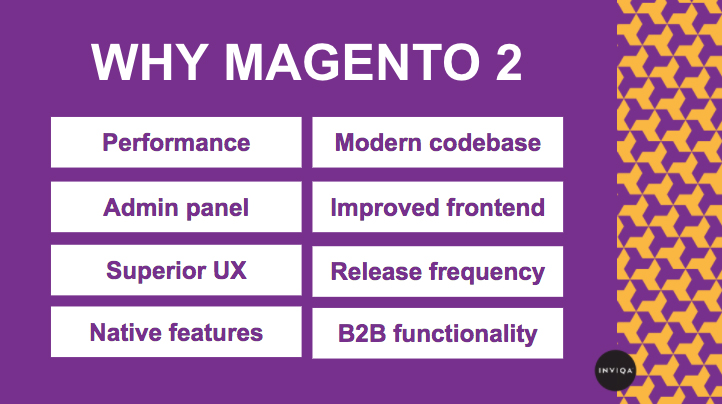Magento Commerce migration: the complete guide
Magento Commerce is one of the most powerful ecommerce platforms on the market. Now that support for Magento 1 versions ended in June 2020, it’s time for retailers to move from Magento 1 to Magento Commerce (Magento 2) in the interests of security and performance. They can also take advantage of other benefits that come with migrating to Magento Commerce, including revenue growth, increased site conversion, and increased site traffic.
(Check out this blog post's accompanying Magento Commerce webinar and SlideShare)
In this complete Magento Commerce upgrade guide, we look at everything you’ll need to consider in your migration plan if you’re thinking of moving to Magento Commerce.
The benefits of Magento Commerce
Magento Commerce (Magento 2) has proven itself to be a significant step-up from Magento 1.x versions, especially when it comes to security, usability and performance. Magento 1.x versions are no longer PCI compliant and websites on Magento 1.x are vulnerable to attacks, due to it not being supported with the latest security patches from Adobe.
Magento Commerce provides lots of new features including a new backend admin panel, a better UX and cleaner interface for admin users, an improved native frontend, more native features, and enhanced B2B functionality.
Magento Commerce sites are typically 20% faster than Magento 1 sites thanks to speed and performance enhancements. Other advantages include a streamlined checkout process and emphasis on mobile responsiveness.
Retailers that have migrated to Magento Commerce are already experiencing cost savings of 62% when deploying new content, thanks to the improved user experience design, which is making it far easier to create and manage content.

(Note: check-out some of our favourite Magento Commerce examples to see what’s possible with the platform).
Magento Commerce is clearly superior to its predecessor and now that there is no support from Adobe for Magento 1.x, retailers that are still on Magento, those outdated versions should urgently make the move to the newer, feature-rich version.
Should I migrate to Magento Commerce?
The first thing to say here is that any decisions you make about a platform should be based on an understanding of that platform's ability to support your business goals.
As with any digital investment, the success of your project will come down to careful planning and assessment of your business requirements, conducted as part of a detailed Discovery or investigation phase.
This needs to happen before you make any major decisions about your next ecommerce platform. Ultimately all key stakeholders need to clearly agree on the goals of the project, the best approach, and the requirements for succeeding with the project.
This process helps an organisation assess the requirements of the project – i.e. whether/why an upgrade is needed, the current pain points, how these can be solved, the required functionality, the effort and estimated budget requirements, and so on.
Once you know these things, you can then decide how best to proceed. Most importantly, you can estimate the project as accurately as possible and work out a reasonable budget.
For the purposes of this guide we’ll assume that you’ve done your due diligence and have decided to move to Magento Commerce.
Is it an upgrade or a replatform?
What’s important to understand is that a Magento 1 to Magento Commerce migration is essentially a re-build, or a re-platforming project. That's because, unlike going from version 1.13 to 1.14, for example, there's no direct upgrade path from 1 to Magento Commerce.
Of course, much of the functionality remains, but there are many new features and a redesigned admin panel. Magento Commerce is very different to Magento 1, which means custom work on your site will need to be reproduced for the new store (as opposed to just being moved over).
So yes, you are going to need to re-build your site from scratch, but fear not; there are a great number of advantages to migrating to Magento Commerce compared to going to an entirely new platform and there a number of things that will make the re-build a lot easier:
- Magento 1.x versions are not PCI Compliant and more at risk of attack
- You won’t have to re-learn the platform; Magento Commerce has a lot of admin improvements but the user experience and processes won’t be alien to you or your teams
- Magento Commerce offers a lot more out-of-the-box functionality (e.g. Page Builder, multi source inventory, and B2B features)
- Magento’s Data Migration Tool simplifies the task of transferring data and checking its consistency to your new Magento Commerce website
As with any digital investment, the success of your project will come down to careful planning and assessment of your business requirements. We recommend that this is conducted as part of a detailed Discovery process.
We always recommend retailers who are undertaking a rebuild to 'release light and release early'. Resist the temptation to add too many features in your first release, because you’ll learn more about your platform if you can rapidly get to market quickly and start capturing real feedback and analysis to inform your decisions regarding any further development.

Don’t try to ‘lift & shift’
Approaching your Magento Commerce move as a straight port of your Magento 1 platform’s features to the new platform may seem like a lower-risk option. But a ‘lift and shift’ approach is not only impossible (MCommerce doesn’t support all M1 features and extensions, for example), it can also impede innovation and increase risk.
A big issue for merchants migrating to Magento Commerce is the cost required to replicate existing functionality where equivalent extensions don’t exist in Magento Commerce. So, if mimicking a feature on your old site doesn’t give you a measurable advantage over your competitors, it’s better to adapt that feature to work within the context of your new platform. This will help you save budget and enable you to innovate in other areas.
Instead of focusing on features you want to port over from your Magento 1 site, it’s better to think in terms of the key business processes, ways of working, and the business value you want to bring to the new platform.

Review your old code
It’s key to look at analytics and get customer feedback to understand how your old site is being used by customers. What features are being used? What’s driving revenue, helping you reduce costs, or giving you a competitive advantage? Use this to inform your decision-making on what to migrate to your new platform.
An upgrade is also a good opportunity to strip out any obsolete code, unused extensions, and redundant functionality from your Magento 1 site. Remember that the more that can be left behind, the more savings you can make, because you could end up spending budget building features that don’t actually add value.
See this as an opportunity to ‘clean up’; the chances are that you’ll have some functionality that isn’t used enough to justify spending budget on upgrading extensions.
It’s also important to have a plan for commodity features – those features that users expect to be there, but don’t provide differentiation or give you a competitive advantage. You should minimise spend on these features, or avoid them altogether, where possible. But remember that what may be a commodity feature for one business may actually be a differentiator for another (a store locator, for example).
Capture the needs of your new system
Building a user story map can be a highly effective way of capturing the high-level needs of a platform while tying those needs into value for users of the system. At its simplest form, it’s about identifying specific user goals from which you derive activities, tasks, and user stories that deliver on that goal.
As they’re collaborative in nature, and often cut across departments and business functions, user story maps are an effective way of creating a shared understanding of what needs to be delivered by the migration.
What’s more, they allow you to understand what the minimum, go-live version of your new platform looks like. For reasons we’ve explored in more depth in a previous article, story mapping is a far more effective way to capture the needs of your new system than using techniques like MoSCoW.
Once you have a story map that gives you a view of your system, you should ask yourself the following at each point of the map to help you make decisions as to how business value is best delivered:
- Does the new platform deliver this value without customisation?
- If not, can you adapt your business processes to work in the way that’s required by the new platform?
- If not, and customisation is required, does the return for that feature justify the investment?
These questions will help you to limit the amount of customisation needed to implement what are often commodity features. Remember that the focus should be on finding the cheapest and easiest ways of delivering the value, rather than the feature.
Minimise risks, maximise returns
Risk mitigation is one of the most important things in replatforming. Your ecommerce system touches many business-critical systems. For many businesses, the ecommerce platform is your main customer touchpoint and many business processes will be baked into this platform.
Projects like this can be expensive if you’re not managing this risk properly. You’ll need clear governance and clean lines of contact, and you should consider what you DON’T need to deliver in time for go-live.
Take frontend design and UX, for example. This is something you build and evolve over time based on analytics and changing user behaviours. To take on a full redesign at the same time as an ecommerce replatform adds a significant amount of risk. What’s more important at this stage is to get a brand or style guide in place and work closely to ensure quality and consistency.
Have a plan for data migration
Remember that all migrations will be different from each other, and that it’s hugely important to get a handle on migrating your data as soon as possible. Ensure you test your data throughout and don’t leave data migration to the last minute.
The following are areas where you’ll need to migrate data to your new platform:
- Historical orders
- Addresses
- Profiles
- Passwords
- URL structure
- Content (articles)
- Products
Use Magento’s Data Migration Tool, a command-line interface that verifies the consistency between Magento 1 and Commerce database structures, to track progress when you’re transferring data to Magento Commerce. Use the tool to create logs and run data verification tests.
Quality assurance (QA) and testing is another really important part of a replatforming project and needs to be planned and factored into every stage to ensure your upgrade work doesn’t have a negative impact on your main journeys – from both a customer and admin user perspective.
Drive innovation
You’ll have limited budget, time, and energy to invest in your ecommerce replatform project. But it’s important to make sure that you have enough to invest in innovation once your new site is live.
The Kano model, developed in the 1980s by Noriaki Kano, offers a useful lens through which to view platform migration projects. By highlighting the difference between basic ‘cost of entry’ features and those features that ‘excite’ end users, the Kano model suggests that we should minimise the effort spent on non-differentiating features. This then gives you the opportunity to retain enough budget to experiment and innovate in areas that will genuinely differentiate you from your competitors.

One way of doing this is to start small; try low-cost experiments and see if they delight your users and drive business value. If they do, invest in further development and testing to see what resonates with your customers.
Our Magento Commerce expertise
Here at Inviqa we’ve been working with Magento Commerce from the beginning as one of only a handful of partners selected to take part in the Magento Commerce beta programme ahead of the platform’s general release.
We launched two of the UK’s first Magento Commerce (Magento 2) websites for Byredo and Graze.com, and our ecommerce experts include some of the UK’s very first Adobe Certified Expert-Magento Commerce Business Practitioner (previously known as Magento 2 Certified Solution Specialists).
Need help? Drop us a line
This article is based on an Inviqa webinar on migrating to Magento Commerce from Magento 1 and we hope it helps you lay the foundations for a solid migration plan as you map your move to Magento Commerce.
Please don’t hesitate to get in touch with your Magento Commerce questions, or if you simply want to talk to our consultants about your ecommerce challenges.
Inviqa is behind the first ever UK site on Magento 2, Missguided’s meteoric ecommerce growth, and Graze’s shift from subscription to ecommerce.
Reach out to us to learn more about our ecommerce credentials and consulting services and how we can support you on your digital journey.





